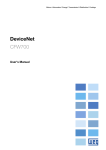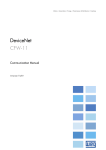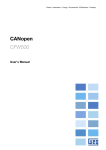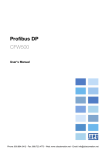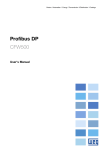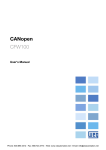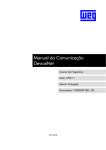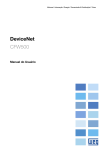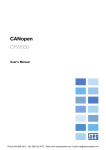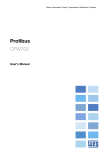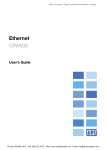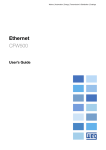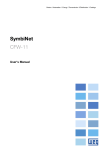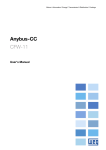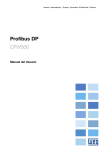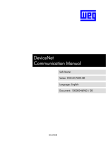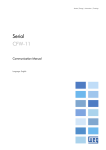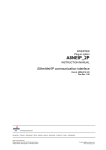Download WEG CFW500 Variable Frequency Drives DeviceNet User`s Manual
Transcript
DeviceNet CFW500 User’s Manual Phone: 800.894.0412 - Fax: 888.723.4773 - Web: www.ctiautomation.net - Email: [email protected] DeviceNet User’s Manual Series: CFW500 Language: English Document Number: 10002253313 / 00 Publication Date: 05/2013 Phone: 800.894.0412 - Fax: 888.723.4773 - Web: www.ctiautomation.net - Email: [email protected] CONTENTS CONTENTS ...............................................................................................................................3 ABOUT THIS MANUAL............................................................................................................5 ABBREVIATIONS AND DEFINITIONS........................................................................................... 5 NUMERICAL REPRESENTATION ................................................................................................ 5 DOCUMENTS ............................................................................................................................ 5 1 INTRODUCTION TO THE DEVICENET COMMUNICATION......................................... 6 1.1 CAN................................................................................................................................. 6 1.1.1 Data Frame................................................................................................................ 6 1.1.2 Remote Frame ........................................................................................................... 6 1.1.3 Access to the Network ............................................................................................... 6 1.1.4 Error Control.............................................................................................................. 6 1.1.5 CAN and DeviceNet.................................................................................................... 7 1.2 DEVICENET NETWORK CHARACTERISTICS...................................................................... 7 1.3 PHYSICAL LAYER ............................................................................................................ 7 1.3.1 Data Link Layer.......................................................................................................... 8 1.3.2 Network and Transport Layer ..................................................................................... 8 1.3.3 Application Layer – CIP Protocol................................................................................. 9 1.3.4 Configuration File (EDS).............................................................................................. 9 1.3.5 Communication Modes .............................................................................................. 9 1.3.6 Set of Predefined Master/Slave Connections ............................................................. 10 2 DEVICENET COMMUNICATION ACCESSORY ........................................................... 11 2.1 2.2 2.3 2.4 2.5 2.6 3 DEVICENET NETWORK INSTALLATION ..................................................................... 13 3.1 3.2 3.3 3.4 3.5 4 PLUG-IN MODULE CFW500-CCAN .................................................................................. 11 CONNECTOR PINOUT .................................................................................................... 11 POWER SUPPLY ............................................................................................................ 11 INDICATIONS................................................................................................................. 11 MODULE CONFIGURATION ............................................................................................ 12 ACCESS TO THE PARAMETERS...................................................................................... 12 BAUD RATE ................................................................................................................... 13 ADDRESS IN THE DEVICENET NETWORK ....................................................................... 13 TERMINATION RESISTOR............................................................................................... 13 CABLE........................................................................................................................... 13 CONNECTION IN THE NETWORK.................................................................................... 13 PROGRAMMING ..............................................................................................................15 4.1 SYMBOLS FOR THE PROPERTIES DESCRIPTION ............................................................ 15 P0105 – 1ST/2ND RAMP SELECTION ............................................................................................ 15 P0220 – LOCAL/REMOTE SELECTION SOURCE ........................................................................ 15 P0221 – SPEED REFERENCE SELECTION – LOCAL SITUATION.................................................. 15 P0222 – SPEED REFERENCE SELECTION – REMOTE SITUATION ............................................... 15 P0223 – FORWARD/REVERSE SELECTION – LOCAL SITUATION ................................................ 15 P0224 – RUN/STOP SELECTION – LOCAL SITUATION................................................................ 15 P0225 – JOG SELECTION – LOCAL SITUATION.......................................................................... 15 P0226 – FORWARD/REVERSE SELECTION – REMOTE SITUATION ............................................. 15 P0227 – RUN/STOP SELECTION – REMOTE SITUATION ............................................................. 15 P0228 – JOG SELECTION – REMOTE SITUATION ....................................................................... 15 P0313 – COMMUNICATION ERROR ACTION.............................................................................. 15 P0680 – STATUS WORD ........................................................................................................... 16 Phone: 800.894.0412 - Fax: 888.723.4773 - Web: www.ctiautomation.net - Email: [email protected] P0681 – MOTOR SPEED IN 13 BITS........................................................................................... 17 P0684 – DEVICENET CONTROL WORD...................................................................................... 18 P0685 – DEVICENET SPEED REFERENCE ................................................................................. 18 P0695 – DIGITAL OUTPUT SETTING.......................................................................................... 19 P0696 – VALUE 1 FOR ANALOG OUTPUTS ................................................................................ 20 P0697 – VALUE 2 FOR ANALOG OUTPUTS ................................................................................ 20 P0698 – VALUE 3 FOR ANALOG OUTPUTS ................................................................................ 20 P0700 – CAN PROTOCOL ......................................................................................................... 21 P0701 – CAN ADDRESS............................................................................................................ 21 P0702 – CAN BAUD RATE......................................................................................................... 21 P0703 – BUS OFF RESET.......................................................................................................... 22 P0705 – CAN CONTROLLER STATUS ........................................................................................ 22 P0706 – RECEIVED CAN TELEGRAM COUNTER ........................................................................ 23 P0707 – TRANSMITTED CAN TELEGRAM COUNTER.................................................................. 23 P0708 – BUS OFF ERROR COUNTER ........................................................................................ 23 P0709 – LOST CAN MESSAGE COUNTER.................................................................................. 23 P0710 – DEVICENET I/O INSTANCES ........................................................................................ 24 P0711 – DEVICENET READING #3 ............................................................................................. 27 P0712 – DEVICENET READING #4 ............................................................................................. 27 P0713 – DEVICENET READING #5 ............................................................................................. 27 P0714 – DEVICENET READING #6 ............................................................................................. 27 P0715 – DEVICENET WRITING #3.............................................................................................. 27 P0716 – DEVICENET WRITING #4.............................................................................................. 27 P0717 – DEVICENET WRITING #5.............................................................................................. 27 P0718 – DEVICENET WRITING #6.............................................................................................. 27 P0719 – DEVICENET NETWORK STATUS................................................................................... 28 P0720 – DEVICENET MASTER STATUS ..................................................................................... 28 5 SUPPORTED OBJECT CLASSES..................................................................................29 5.1 IDENTITY CLASS (01H) ................................................................................................... 29 5.2 MESSAGE ROUTER CLASS (02H) .................................................................................... 29 5.3 DEVICENET CLASS (03H)................................................................................................ 29 5.4 ASSEMBLY CLASS (04H) ................................................................................................ 29 5.5 CONNECTION CLASS (05H) ............................................................................................ 30 5.5.1 Instance 1: Explicit Message..................................................................................... 30 5.5.2 Instance 2: Polled..................................................................................................... 30 5.5.3 Instance 4: Change of State/Cyclic............................................................................ 31 5.6 MOTOR DATA CLASS (28H) ............................................................................................ 31 5.7 CONTROL SUPERVISOR CLASS (29H)............................................................................. 31 5.8 AC/DC DRIVE CLASS (2AH)............................................................................................. 32 5.9 ACKNOWLEDGE HANDLER CLASS (2BH) ........................................................................ 32 5.10 MANUFACTURER SPECIFIC CLASSES......................................................................... 33 6 FAULTS AND ALARMS RELATED TO THE DEVICENET COMMUNICATION......... 34 A133/F233 – CAN INTERFACE WITHOUT POWER SUPPLY ......................................................... 34 A134/F234 – BUS OFF .............................................................................................................. 34 A136/F236 – IDLE MASTER....................................................................................................... 34 A137/F237 – DEVICENET CONNECTION TIMEOUT..................................................................... 35 Phone: 800.894.0412 - Fax: 888.723.4773 - Web: www.ctiautomation.net - Email: [email protected] ABOUT THIS MANUAL This manual provides the necessary information for the operation of the CFW500 frequency converter using the DeviceNet protocol. This manual must be used together with the CFW500 user manual. ABBREVIATIONS AND DEFINITIONS ASCII CAN CiA CIP PLC HMI ODVA ro rw American Standard Code for Information Interchange Controller Area Network CAN in Automation Common Industrial Protocol Programmable Logic Controller Human-Machine Interface Open DeviceNet Vendor Association Read only Read/write NUMERICAL REPRESENTATION Decimal numbers are represented by means of digits without suffix. Hexadecimal numbers are represented with the letter ‘h’ after the number. DOCUMENTS The DeviceNet protocol was developed based on the following specifications and documents: Document CAN Specification Volume One Common Industrial Protocol (CIP) Specification Volume Three DeviceNet Adaptation of CIP Version 2.0 3.2 Source CiA ODVA 1.4 ODVA In order to obtain this documentation, consult ODVA, which is nowadays the organization that keeps, publishes and updates the information related to the DeviceNet network. Phone: 800.894.0412 - Fax: 888.723.4773 - Web: www.ctiautomation.net - Email: [email protected] 1 INTRODUCTION TO THE DEVICENET COMMUNICATION In order to operate the equipment in a DeviceNet network, it is necessary to know the manner this communication is performed. Therefore, this section brings a general description of the DeviceNet protocol operation, containing the functions used by the CFW500. Refer to the protocol specification for a detailed description. 1.1 CAN DeviceNet is a network based on CAN, i.e., it uses CAN telegrams for exchanging data in the network. The CAN protocol is a serial communication protocol that describes the services of layer 2 of the ISO/OSI model (data link layer) 1 . This layer defines the different types of telegrams (frames), the error detection method, the validation and arbitration of messages. 1.1.1 Data Frame CAN network data is transmitted by means of a data frame. This frame type is composed mainly by an 11 bit 2 identifier (arbitration field), and by a data field that may contain up to 8 data bytes. Identifier 11 bits byte 0 byte 1 1.1.2 8 data bytes byte 2 byte 3 byte 4 byte 5 byte 6 byte 7 Remote Frame Besides the data frame, there is also the remote frame (RTR frame). This type of frame does not have a data field, but only the identifier. It works as a request, so that another network device transmits the desired data frame. The DeviceNet communication protocol does not use this type of frame. 1.1.3 Access to the Network Any device in a CAN network can make an attempt to transmit a frame to the network in a certain moment. If two devices try to access the network simultaneously, the one that sends the message with the highest priority will be able to transmit. The message priority is defined by the CAN frame identifier, the smaller the value of this identifier, the higher the message priority. The telegram with the identifier 0 (zero) is the one with the highest priority. 1.1.4 Error Control The CAN specification defines several error control mechanisms, which makes the network very reliable and with a very low undetected transmission error rate. Every network device must be able to identify the occurrence of these errors, and to inform the other elements that an error was detected. A CAN network device has internal counters that are incremented every time a transmission or reception error is detected, and are decremented when a telegram is successfully transmitted or received. If a considerable amount of errors occurs, the device can be led to the following states: Error Active: the internal error counters are at a low level and the device operates normally in the CAN network. You can send and receive telegrams and act in the CAN network if it detects any error in the transmission of telegrams. Warning: when the counter exceeds a defined limit, the device enters the warning state, meaning the occurrence of a high error rate. Error Passive: when this value exceeds a higher limit, the device enters the error passive state, and it stops acting in the network when detecting that another device sent a telegram with an error. Bus Off: finally, we have the bus off state, in which the device will not send or receive telegrams any more. The device operates as if disconnected from the network. 1 In the CAN protocol specification, the ISO11898 standard is referenced as the definition of the layer 1 of this model (physical layer). The CAN 2.0 specification defines two data frame types, standard (11 bit) and extended (29 bit). For this implementation, only the standard frames are accepted. 2 Phone: 800.894.0412 - Fax: 888.723.4773 - Web: www.ctiautomation.net - Email: [email protected] 1.1.5 CAN and DeviceNet Only the definition of how to detect errors, create and transmit a frame, are not enough to define a meaning for the data transmitted via the network. It is necessary to have a specification that indicates how the identifier and the data must be assembled and how the information must be exchanged. Thus, the network elements can interpret the transmitted data correctly. In that sense, the DeviceNet specification defines exactly how to exchange data among the devices and how every one must interpret these data. There are several other protocols based on CAN, as DeviceNet, CANopen, J1939, etc., which use CAN frames for the communication. However, those protocols cannot be used together in the same network. 1.2 DEVICENET NETWORK CHARACTERISTICS Introduced in 1994, DeviceNet is an implementation of the Common Industrial Protocol (CIP) for industrial communication networks. Developed originally by Allen-Bradley, it had its technology transferred to the ODVA that, since then, keeps, publishes and promotes DeviceNet and other networks based on the CIP 3 protocol. Furthermore, it uses the Controller Area Network (CAN) protocol for the data link and access to the medium, layers 2 and 1 of the OSI/ISO model, respectively. Used mainly for the connection of industrial controllers and I/O devices, the protocol follows the model producer-consumer, supports multiple communication modes and has priority between messages. It is a system that can be configured to operate in master-slave architecture as well as in a distributed point-topoint architecture. Besides, it defines two kinds of messages, I/O (process data) and explicit (configuration and parameter setting). It also has mechanisms to detect duplicated addresses and for node isolation in case of critical faults. A DeviceNet network can have up to 64 devices, addressed from 0 to 63. Any of them can be used. There is no restriction, although the 63 should be avoided because it is usually used for commissioning. 1.3 PHYSICAL LAYER DeviceNet uses a network topology of the trunk/derivation type that allows the signal wiring as well as the power wiring to be present in the same cable. This power is supplied by a power supply connected directly to the network, which feeds the CAN transceivers of the nodes, and has the following characteristics: 24 Vdc; DC output isolated from the AC input; Current capacity compatible with the installed equipment. The used Baud rate depends on the size (cable length) of the network, as showed in the table 1.1. Table 1.1: Network size x Baud rate Derivation Maximum Total 6m 156 m 125 kbps Network Size 500 m 250 kbps 250 m 78 m 500 kbps 100 m 39 m Baud Rate In order to avoid reflections in the line, it is recommended the installation of termination resistors at the line extremes, because the absence of them may cause intermittent errors. This resistor must have the following characteristics, according to the protocol specification: 121 Ω; 0.25 W; 1% tolerance. 3 CIP actually represents a family of networks. DeviceNet, EtherNet/IP and ControlNet use CIP in the application layer. The difference among them is primordially in the data link and physical layers. Phone: 800.894.0412 - Fax: 888.723.4773 - Web: www.ctiautomation.net - Email: [email protected] For DeviceNet, several types of connectors can be used, sealed ones as well as open ones. The definition of the type to be used depends on the application and on the equipment operation environment. The CFW500 uses a 5 wire plug-in connector, and its pinout is showed in the section 2. For a complete description of the connectors used with DeviceNet, consult the protocol specification. 1.3.1 Data Link Layer The DeviceNet data link layer is defined by the CAN specification, which defines two possible states; dominant (logic level 0) and recessive (logic level 1). A node can bring the network to the dominant state if it transmits any information. Thus, the bus will only be in the recessive state if there where no transmitting nodes in the dominant state. CAN uses the CSMA/NBA to access the physical medium. This means that a node, before transmitting, must verify if the bus is free. In case it is, then the node can initiate the transmission of its telegram. In case it is not, then the node must await. If more than one node access the network simultaneously, a priority mechanism takes action to decide which one will have priority over the others. This mechanism is not destructive, i.e., the message is preserved even if there is a collision between two or more telegrams. CAN defines four types of telegrams (data, remote, overload and error). Among them, DeviceNet uses only the data frame and the error frame. 1 bit 11 bits 1 bit 6 bits 0-8 bytes 15 bits 1 bit 1 bit 1 bit 7 bits ≥ 3 bits Identifier RTR bit Control Field Data Field CRC Sequence CRC Delimiter ACK Slot ACK Delimiter End of Frame Interframe Space Interframe Space Start of Frame Data is moved using the data frame. This frame structure is showed in the figure 1.1. Figure 1.1: CAN data frame Errors, however, are indicated by means of the error frames. CAN has a very robust error verification and confinement. This assures that a node with problems does not impair the communication in the network. For a complete description of the errors, consult the CAN specification. 1.3.2 Network and Transport Layer DeviceNet requires that a connection be established before data exchange with the device takes place. In order to establish this connection each DeviceNet node must implement the Unconnected Message Manager (UCMM) or the Group 2 Unconnected Port. These two allocation mechanisms use messages of the explicit type to establish a connection, which will then be used for process data exchange between one node and the other. This data exchange uses messages of the I/O type (refer to item 1.3.5). The DeviceNet telegrams are classified in groups, which define specific functions and priorities. Those telegrams use the identifier field (11 bits) of the CAN data frame to uniquely identify each one of the messages, thus assuring the CAN priority mechanism. A DeviceNet node can be a client, a server or both. Furthermore, clients and servers can be producers and/or consumers of messages. In a typical client node, for instance, its connection will produce requests and will consume answers. Other client or server connections will only consume messages. In other words, the protocol allows several connection possibilities among the devices. The protocol also has a resource for detection of nodes with duplicated addresses (Mac ID). Avoiding that duplicated addresses occur is, in general, more efficient than trying to locate them later. Phone: 800.894.0412 - Fax: 888.723.4773 - Web: www.ctiautomation.net - Email: [email protected] 1.3.3 Application Layer – CIP Protocol In the application layer, DeviceNet uses the Common Industrial Protocol (CIP). It is a protocol strictly orientated to objects, used also by ControlNet and EtherNet/IP. In other words, it is independent from the physical medium and from the data link layer. The figure 1.2 presents the structure of this protocol. Figure 1.2: CIP protocol structure in layers The CIP has two main purposes: Transport of I/O devices control data. Transport of configuration and diagnosis information of the system being controlled. A DeviceNet node (master or slave) is then molded by a set of CIP objects, which encapsulate data and services, thus determining its behavior. There are obligatory objects (each device must have) and optional objects. Optional objects are those that mold the device according to the category (called profile) to which they belong, as: AC/DC drive, bar code reader or pneumatic valve. For being different, each one of these will contain a group of also different objects. For more information refer to the DeviceNet specification. It presents the complete list of devices already standardized by the ODVA, as well as the objects that compose them. 1.3.4 Configuration File (EDS) Each device in a DeviceNet network has an EDS configuration file that contains information about the device operation and must be registered in the network configuration software, for programming of devices present in the DeviceNet Network. The EDS configuration file is supplied together with the product, and it can also be obtained from the website. It is necessary to observe the equipment software version, in order to use an EDS file that is compatible with that version. 1.3.5 Communication Modes The DeviceNet protocol presents two basic types of messages, I/O and explicit. Each one of them is adequate to a specific kind of data, as described below: Phone: 800.894.0412 - Fax: 888.723.4773 - Web: www.ctiautomation.net - Email: [email protected] I/O: it is a kind of synchronous telegram dedicated to the movement of priority data between one producer and one or more consumers. They are divided according to the data exchange method. The main types are: Polled: it is a communication method where the master sends one telegram to each of the slaves of its list (scan list). As soon as receiving the request, the slave responds promptly to the request from the master. This process is repeated until all be consulted, restarting the cycle. Bit-strobe: it is a communication method where the master sends to the network a telegram containing 8 data bytes. Each bit from those 8 bytes represents a slave that, if addressed, responds according to the programmed. Change of State: it is a communication method where the data exchange between master and slave occurs only when changes in the monitored/controlled values happened, until a certain time limit. When this limit is reached, the transmission and reception will occur even if there were no changes. The configuration of this time variable is done in the network configuration program. Cyclic: it is another communication method very similar to the previous one. The only difference stays in the production and consume of messages. In this type, every data exchange occurs in regular time intervals, whether or not they had been changed. This time period is also adjusted in the network configuration software. Explicit: it is a kind of general purpose telegram and without priority. It is mainly used for asynchronous tasks like the parameter settings and the configuration of the equipment. NOTE! The CFW500 frequency converter does not provide the bit-strobe communication method. 1.3.6 Set of Predefined Master/Slave Connections DeviceNet uses fundamentally a point-to-point message model. However, it is quite common to use a predefined communication model based on the master/slave mechanism. This model uses a simplified message movement of the I/O type, very common in control applications. An advantage of this method is that the necessary requests to run it are generally less than for the UCMM. Even simple devices with limited resources (memory, 8 bit processor) are capable of executing the protocol. Phone: 800.894.0412 - Fax: 888.723.4773 - Web: www.ctiautomation.net - Email: [email protected] 2 DEVICENET COMMUNICATION ACCESSORY In order to make the DeviceNet communication possible with the product, it is necessary to use the CAN communication kit described next. Information on the installation of this module can be obtained in the guide that comes with the kit. 2.1 PLUG-IN MODULE CFW500-CCAN 2.2 WEG part number: 11593087 Composed by the CAN communication module (drawing at the left), mounting instruction and fixing screw. The interface is electrically isolated and with differential signal, which grants more robustness against electromagnetic interference. External 24V supply. It allows the connection of up to 64 devices to the same segment. More devices can be connected by using repeaters 4. A maximum bus length of 1000 meters. CONNECTOR PINOUT The CAN communication module presents a 5-wire plug-in connector with the following pinout: Table 2.1: CAN interface connector pinout Pin 1 2 3 4 5 Name VCAN_L Shield CAN_H V+ Function Power supply negative pole CAN_L communication signal Cable shield CAN_H communication signal Power supply positive pole NOTE! It is recommended to connect the GND pin of the CFW500-CCAN module to protective earth. This is necessary to connect the cable shield with the earth. 2.3 POWER SUPPLY The CAN interface needs an external power supply between the pins 1 and 5 of the network connector. The individual consumption and input voltage data are presented in the next table. Table 2.2: CAN interface supply characteristics Supply Voltage (VDC) Maximum Recommended 30 24 Current (mA) Typical Maximum 30 50 Minimum 11 2.4 INDICATIONS Details on the alarms, communications failures and communication states are made through the keypad (HMI) and product parameters. 4 The maximum number of devices that can be connected to the network depends also on the used protocol. Phone: 800.894.0412 - Fax: 888.723.4773 - Web: www.ctiautomation.net - Email: [email protected] 2.5 MODULE CONFIGURATION In order to configure the DeviceNet module follow the steps indicated below: 2.6 With the frequency converter powered off install the plug-in module CFW500-CCAN. Make sure it is properly fitted into the connector and secured by the screw. Power up the inverter. Verify the content of the parameter P0027 making sure the accessory was correctly recognized. If necessary, refer to the installation guide. Set the CAN protocol for DeviceNet by means of the parameter P0700. Adjust the address of the inverter in the network through the parameter P0701. Valid values: 0 to 63. Set the Baud Rate in P0702. Valid values: 0 = Auto 1 = Auto 2 = 500kbps 3 = 250kbps 4 = 125kbps 5 = Auto 6 = Auto 7 = Auto 8 = Auto At the parameter P0710, configure the most suitable I/O instance for the application (this choice will impact the number of words exchanged with the network master). The very same number of words must be adjusted at the network master. Finally, program a value different from 0 in the parameters P0711 to P0718. Valid values: 0 a 1199. Cycle the power of the CFW500, so that the changes become effective. Connect the network cable to the module. Register the configuration file (EDS file) in the network configuration software. Add the CFW500 to the scan list of the master. In the network configuration software, choose a method of data exchange with the master, i.e., polled, change of state or cyclic. The CFW500 DeviceNet module supports all these I/O data types, besides the explicit (acyclic data). If everything is configured correctly the parameter P0719 will indicate the “Online Connected” state. Observe also the parameter that indicates the network master status, P0720. There will only be effective data exchange when the master status is Run. ACCESS TO THE PARAMETERS After the EDS file registration in the network configuration software, the user will get access to the equipment complete parameter list, which can be accessed via explicit messages. This means that it is possible to perform the drive programming and configuration through the network configuration software. In order to get application details of this resource, refer to the network master programming documentation (PLC, PC, etc.). Phone: 800.894.0412 - Fax: 888.723.4773 - Web: www.ctiautomation.net - Email: [email protected] 3 DEVICENET NETWORK INSTALLATION The DeviceNet network, such as several industrial communication networks, for being many times applied in aggressive environments with high exposure to electromagnetic interference, requires that certain precautions be taken in order to guarantee a low communication error rate during its operation. Recommendations to perform the connection of the product in this network are presented next. 3.1 BAUD RATE Equipments with DeviceNet interface generally allow the configuration of the desired baud rate, ranging from 125Kbit/s to 500Kbit/s. The baud rate that can be used by equipment depends on the length of the cable used in the installation. The next table shows the baud rates and the maximum cable length that can be used in the installation, according to the ODVA recommendation 5. Table 3.1: Supported baud rates and installation size Baud Rate 500 Kbit/s 250 Kbit/s 125 Kbit/s Cable Length 100 m 250 m 500 m All network equipment must be programmed to use the same communication baud rate. At the CFW500 frequency converter the baud rate configuration is done through the parameter P0702. 3.2 ADDRESS IN THE DEVICENET NETWORK Each DeviceNet network device must have an address or MAC ID, and may range from 0 to 63. This address must be unique for each equipment. For CFW500 frequency converter the address configuration is done through the parameter P0701. 3.3 TERMINATION RESISTOR The CAN bus line must be terminated with resistors to avoid line reflection, which can impair the signal and cause communication errors. The extremes of the CAN bus must have a termination resistor with a 121Ω / 0.25W value, connecting the CAN_H and CAN_L signals. 3.4 CABLE The connection of CAN_L and CAN_H signals must done with shielded twisted pair cable. The following table shows the recommended characteristics for the cable. Table 3.2: DeviceNet cable characteristics Cable length (m) 0 ... 40 40 ... 300 300 ... 600 600 ... 1000 Resistance per meter (mOhm/m) 70 <60 <40 <26 Conductor cross section (mm2) 0.25 ... 0.34 0.34 ... 0.60 0.50 ... 0.60 0.75 ... 0.80 It is necessary to use a twisted pair cable to provide additional 24Vdc power supply to equipments that need this signal. It is recommended to use a certified DeviceNet cable. 3.5 CONNECTION IN THE NETWORK In order to interconnect the several network nodes, it is recommended to connect the equipment directly to the main line without using derivations. During the cable installation the passage near to power cables must be avoided, because, due to electromagnetic interference, this makes the occurrence of transmission errors possible. In order to avoid problems with current circulation caused by difference of potential among ground connections, it is necessary that all the devices be connected to the same ground point. 5 Different products may have different maximum allowed cable length for installation. Phone: 800.894.0412 - Fax: 888.723.4773 - Web: www.ctiautomation.net - Email: [email protected] Figure 3.1: DeviceNet network installation example To avoid voltage difference problems between the power supplies of the network devices, it is recommended that the network is fed by only one power supply and the signal is provided to all devices through the cable. If it is required more than one power supply, these should be referenced to the same point. The maximum number of devices connected to a single segment of the network is limited to 64. Repeaters can be used for connecting a bigger number of devices. Phone: 800.894.0412 - Fax: 888.723.4773 - Web: www.ctiautomation.net - Email: [email protected] 4 PROGRAMMING Next, only the CFW500 frequency converter parameters related to the DeviceNet communication will be presented. 4.1 SYMBOLS FOR THE PROPERTIES DESCRIPTION RO CFG CAN Read-only parameter Parameter that can be changed only with a stopped motor Parameter visible on the HMI if the product has the CAN interface installed P0105 – 1ST/2ND RAMP SELECTION P0220 – LOCAL/REMOTE SELECTION SOURCE P0221 – SPEED REFERENCE SELECTION – LOCAL SITUATION P0222 – SPEED REFERENCE SELECTION – REMOTE SITUATION P0223 – FORWARD/REVERSE SELECTION – LOCAL SITUATION P0224 – RUN/STOP SELECTION – LOCAL SITUATION P0225 – JOG SELECTION – LOCAL SITUATION P0226 – FORWARD/REVERSE SELECTION – REMOTE SITUATION P0227 – RUN/STOP SELECTION – REMOTE SITUATION P0228 – JOG SELECTION – REMOTE SITUATION These parameters are used in the configuration of the command source for the CFW500 frequency converter local and remote situations. In order that the device be controlled through the DeviceNet interface, the options ‘CANopen/DeviceNet/Profibus DP’ available in these parameters, must be selected. The detailed description of these parameters is found in the CFW500 programming manual. P0313 – COMMUNICATION ERROR ACTION Range: 0 = Inactive 1 = Disable via Run/Stop 2 = Disable via General Enable 3 = Change to Local 4 = Change to Local keeping commands and reference 5 = Causes a Fault Properties: CFG Access groups via HMI: NET Default: 1 Description: It allows the selection of the action to be executed by the device, if it is controlled via network and a communication error is detected. Phone: 800.894.0412 - Fax: 888.723.4773 - Web: www.ctiautomation.net - Email: [email protected] Table 4.1: P0313 options Options 0 = Inactive 1 = Disable via Run/Stop 2 = Disable via General Enable 3 = Change to Local 4 = Change to Local keeping commands and reference 5 = Causes a Fault Description No action is taken and the drive remains in the existing status. A stop command with deceleration ramp is executed and the motor stops according to the programmed deceleration ramp. The drive is disabled by removing the General Enabling and the motor coasts to stop. The drive commands change to Local. The drive commands change to Local, but the status of the enabling and speed reference commands received via network are kept, providing that the drive has been programmed to use in Local mode the commands via HMI, or 3-wire start/stop and speed reference via either HMI or electronic potentiometer. Instead of an alarm, the communication error causes an drive fault, so that a drive fault reset becomes necessary in order to restore normal operation. The following events are considered communication errors: CANopen/DeviceNet communication: A133 alarm/F233 fault: CAN interface not powered. A134 alarm/F234 fault: bus off. A135 alarm/F235 fault: CANopen communication error (Node Guarding/Heartbeat). A136 alarm/F236 fault: DeviceNet master in Idle mode. A137 alarm/F237 fault: Detected timeout in one or more DeviceNet I/O connections. The actions described in this parameter are executed by means of the automatic writing of the selected actions in the respective bits of the interface control words. Therefore, in order that the commands written in this parameter be effective, it is necessary that the device be programmed to be controlled via the used network interface (with exception of option “Causes a Fault”, which blocks the equipment even if it is not controlled by network). This programming is achieved by means of parameters P0220 to P0228. P0680 – STATUS WORD Range: 0000h to FFFFh Properties: RO Access groups via HMI: NET Default: - Bits 15 14 13 12 11 10 9 8 7 6 5 4 3 to 0 Function Fault condition (PID) Automatic Undervoltage LOC/REM JOG Speed direction Active General Enable Motor Running Alarm condition In configuration mode Second ramp Active fast stop Reserved Description: It allows the device status monitoring. Each bit represents a specific status: Phone: 800.894.0412 - Fax: 888.723.4773 - Web: www.ctiautomation.net - Email: [email protected] Table 4.2: P0680 parameter bit functions Bits Bits 0 to 3 Bit 4 Active quick stop Bit 5 Second ramp Bit 6 In configuration mode Bit 7 Alarm condition Bit 8 Motor Running Bit 9 Active General Enable Bit 10 Speed direction Bit 11 JOG Bit 12 LOC/REM Bit 13 Undervoltage Bit 14 Manual/ Automatic Bit 15 Fault condition Values Reserved. 0: The fast stop command is not active. 1: The drive is executing the fast stop command. 0: The drive is configured to use the first ramp values, programmed in P0100 and P0101, as the motor acceleration and deceleration ramp times. 1: The drive is configured to use the second ramp values, programmed in P0102 and P0103, as the motor acceleration and deceleration ramp times. 0: The drive is operating normally. 1: The drive is in the configuration mode. It indicates a special condition during which the drive cannot be enabled: Executing the self-tuning routine Executing the oriented start-up routine Executing the HMI copy function Executing the flash memory card self-guided routine There is a parameter setting incompatibility There is no power at the drive power section 0: The drive is not in alarm condition. 1: The drive is in alarm condition. Note: The alarm number can be read by means of the parameter P0048 – Present Alarm. 0: The motor is stopped. 1: The drive is running the motor at the set point speed, or executing either the acceleration or the deceleration ramp. 0: General Enable is not active. 1: General Enable is active and the drive is ready to run the motor. 0: The motor is running in the reverse direction. 1: The motor is running in the forward direction. 0: Inactive JOG function. 1: Active JOG function. 0: Drive in Local mode. 1: Drive in Remote mode. 0: No Undervoltage. 1: With Undervoltage. 0: PID in manual mode. 1: PID in Automatic mode. 0: The drive is not in a fault condition. 1: The drive has detected a fault. Note: The fault number can be read by means of the parameter P0049 – Present Fault. P0681 – MOTOR SPEED IN 13 BITS Range: - 32768 to 32767 Properties: RO Access groups via HMI: NET Default: - Description: It allows monitoring the motor speed. This word uses 13-bit resolution with signal to represent the motor rated frequency (P0403): P0681 = 0000h (0 decimal) P0681 = 2000h (8192 decimal) → motor speed = 0 → motor speed = rated frequency Intermediate or higher speed values in rpm can be obtained by using this scale. E.g.60Hz rated frequency if the value read is 2048 (0800h), then, to obtain the speed in Hz one must calculate: 8192 => 60 Hz 2048 => Frequency in Hz Frequency in Hz = 60 × 2048 8192 Frequency in Hz = 30 Hz Negative values in this parameter indicate that the motor is running in the reverse direction. Phone: 800.894.0412 - Fax: 888.723.4773 - Web: www.ctiautomation.net - Email: [email protected] NOTE! The values transmitted over the network have a scale limitation, allowing a maximum of 4 times the synchronous speed of the motor, with saturation in 32767 (or -32768). P0684 – DEVICENET CONTROL WORD Range: 0000h a FFFFh Properties: NET Access groups via HMI: NET Default: 0000h Description: It is the device DeviceNet interface control word. This parameter can only be changed via CANopen/DeviceNet/Profibus DP interface. For the other sources (HMI, etc.) it behaves like a read-only parameter. In order to have those commands executed, it is necessary to program the equipment to be controlled via CANopen/DeviceNet/Profibus DP. This programming is achieved by means of parameters P0105 and P0220 to P0228. 6 5 4 3 2 1 0 Second ramp LOC/REM JOG Speed direction General enable Run/Stop Function 7 Quick stop 15 to 8 Fault reset Bits Reserved Each bit of this word represents a command that can be executed. Table 4.3: P0684 parameter bit functions Bits Bit 0 Run/Stop Bit 1 General enable Bit 2 Speed direction Bit 3 JOG Bit 4 LOC/REM Bit 5 Second ramp Bit 6 Quick stop Bit 7 Fault reset Bits 8 to 15 Values 0: It stops the motor with deceleration ramp. 1: The motor runs according to the acceleration ramp until reaching the speed reference value. 0: It disables the drive, interrupting the supply for the motor. 1: It enables the drive allowing the motor operation. 0: To run the motor in a direction opposed to the speed reference. 1: To run the motor in the direction indicated by the speed reference. 0: It disables the JOG function. 1: It enables the JOG function. 0: The drive goes to the Local mode. 1: The drive goes to the Remote mode. 0: The drive uses the first ramp values, programmed in P0100 and P0101, as the motor acceleration and deceleration ramp times. 1: The drive is configured to use the second ramp values, programmed in P0102 and P0103, as the motor acceleration and deceleration ramp times. 0: It does not execute the quick stop command. 1: It executes the quick stop command. Note: This function is not allowed with control types (P0202) V/f or VVW. 0: No function. 1: If in a fault condition, then it executes the reset. Reserved. P0685 – DEVICENET SPEED REFERENCE Range: -32768 to 32767 Properties: NET Access groups via HMI: NET Default: 0 Description: It allows programming the motor speed reference via the DeviceNet interface. This parameter can only be changed via CANopen/DeviceNet/Profibus DP interface. For the other sources (HMI, etc.) it behaves like a readonly parameter. Phone: 800.894.0412 - Fax: 888.723.4773 - Web: www.ctiautomation.net - Email: [email protected] In order that the reference written in this parameter be used, it is necessary that the drive be programmed to use the speed reference via CANopen/DeviceNet/Profibus DP. This programming is achieved by means of parameters P0221 and P0222. This word uses a 13-bit resolution with signal to represent the motor rated frequency (P0403). P0685 = 0000h (0 decimal) P0685 = 2000h (8192 decimal) → speed reference = 0 → speed reference = rated frequency (P0403) Intermediate or higher reference values can be programmed by using this scale. E.g.60Hz rated frequency, to obtain a speed reference of 30 Hz one must calculate: 60 Hz => 8192 30 Hz => 13 bit reference 13 bit reference = 30 × 8192 60 => Value corresponding to 30 Hz in a 13 bit scale 13 bit reference = 4096 This parameter also accepts negative values to revert the motor speed direction. The reference speed direction, however, depends also on the control word - P0684 - bit 2 setting: Bit Bit Bit Bit 2= 2= 2= 2= 1 and P0685 > 1 and P0685 < 0 and P0685 > 0 and P0685 < 0: 0: 0: 0: reference reference reference reference for forward direction for reverse direction for reverse direction for forward direction NOTE! The values transmitted over the network have a scale limitation, allowing to program a speed reference of 4 times the synchronous speed of the motor at most. P0695 – DIGITAL OUTPUT SETTING Range 0000h to 001Fh Properties: NET Access groups via HMI: NET Default: 0000h Description: It allows the control of the digital outputs by means of the network interfaces (Serial, CAN, etc.). This parameter cannot be changed via HMI. Bits 15 to 5 4 3 2 1 0 Function Reserved DO5 setting DO4 setting DO3 setting DO2 setting DO1 setting Each bit of this parameter corresponds to the desired value for one digital output. In order to have the correspondent digital output controlled according to this content, it is necessary that its function be programmed for “P0695 Content” at parameters P0275 to P0279. Phone: 800.894.0412 - Fax: 888.723.4773 - Web: www.ctiautomation.net - Email: [email protected] Table 4.4: P0695 parameter bit functions Bits Bit 0 DO1 setting Bit 1 DO2 setting Bit 2 DO3 setting Bit 3 DO4 setting Bit 4 DO5 setting Bits 5 to 15 Values 0: DO1 output open. 1: DO1 output closed. 0: DO2 output open. 1: DO2 output closed. 0: DO3 output open. 1: DO3 output closed. 0: DO4 output open. 1: DO4 output closed. 0: DO5 output open. 1: DO5 output closed. Reserved NOTE! Some of the digital outputs may not be available depending on the plug-in module. P0696 – VALUE 1 FOR ANALOG OUTPUTS P0697 – VALUE 2 FOR ANALOG OUTPUTS P0698 – VALUE 3 FOR ANALOG OUTPUTS Range: -32768 to 32767 Properties: NET Access groups via HMI: NET Default: 0 Description: They allow the control of the analog outputs by means of network interfaces (Serial, CAN, etc.) These parameters cannot be changed via HMI. The value written in these parameters is used as the analog output value, providing that the function for the desired analog output be programmed for “P0696 / P0697 / P0698 value”, at the parameters P0251, P0254, P0257. The value must be written in a 15-bit scale (7FFFh = 32767) 6 to represent 100 % of the output desired value, i.e.: P0696 = 0000h (0 decimal) → analog output value = 0 % P0696 = 7FFFh (32767 decimal) → analog output value = 100 % The showed example was for P0696, but the same scale is also used for the parameters P0697 / P0698. For instance, to control the analog output 1 via serial, the following programming must be done: Choose a parameter from P0696, P0697, P0698 to be the value used by the analog output 1. For this example, we are going to select P0696. Program the option “P0696 value” as the function for the analog output 1 in P0254. Using the network interface, write in P0696 the desired value for the analog output 1, between 0 and 100%, according to the parameter scale. NOTE! For CFW500 frequency converter, the analog output 3 represents the frequency output (FO). 6 For the actual output resolution, refer to the product manual. Phone: 800.894.0412 - Fax: 888.723.4773 - Web: www.ctiautomation.net - Email: [email protected] P0700 – CAN PROTOCOL Range: 1 = CANopen 2 = DeviceNet Properties: CFG Access groups via HMI: NET Default: 2 Description: It allows selecting the desired protocol for the CAN interface. If this parameter is changed, the change takes effect only if the CAN interface is not powered, it is in auto-baud or after the equipment is switched off and on again. P0701 – CAN ADDRESS Range: 0 to 127 Properties: CFG Access groups via HMI: Default: 63 NET Description: It allows programming the address used for the CAN communication. It is necessary that each element of the network has an address different from the others. The valid addresses for this parameter depend on the protocol programmed in P0700: P0700 = 1 (CANopen) P0700 = 2 (DeviceNet) → valid addresses: 1 to 127. → valid addresses: 0 to 63. If this parameter is changed, the change takes effect only if the CAN interface is not powered, auto-baud or after the equipment is switched off and on again. P0702 – CAN BAUD RATE 0 = 1 Mbit/s / Autobaud 1 = 800 Kbit/s / Autobaud 2 = 500 Kbit/s 3 = 250 Kbit/s 4 = 125 Kbit/s 5 = 100 Kbit/s / Autobaud 6 = 50 Kbit/s / Autobaud 7 = 20 Kbit/s / Autobaud 8 = 10 Kbit/s / Autobaud Properties: CFG Access groups via HMI: NET Range: Default: 0 Description: It allows programming the desired baud rate for the CAN interface, in bits per second. This rate must be the same for all the devices connected to the network. The supported bauld rates for the device depend on the protocol programmed in the parameter P0700: P0700 = 1 (CANopen): It is possible to use any rate specified in this parameter, but it does not have the automatic baud rate detection function – autobaud. P0700 = 2 (DeviceNet): only the 500, 250 and 125 Kbit/s rates are supported. Other options will enable the automatic baud rate detection function – autobaud. If this parameter is changed, the change takes effect only if the CAN interface is not powered or after the equipment is switched off and on again. After a successful detection, the baud rate parameter (P0702) changes automatically to the detected rate. In order to execute the autobaud function again, it is necessary to change the parameter P0702 to one of the ‘Autobaud’ options. Phone: 800.894.0412 - Fax: 888.723.4773 - Web: www.ctiautomation.net - Email: [email protected] P0703 – BUS OFF RESET Range: Default: 0 0 = Manual 1 = Automatic Properties: CFG Access groups via HMI: NET Description: It allows programming the inverter behavior when detecting a bus off error at the CAN interface: Table 4.5: Options for the parameter P0703 Option 0 = Manual Reset Description If bus off occurs, the A134/F234 alarm will be indicated on the HMI, the action programmed in parameter P0313 will be executed and the communication will be disabled. In order that the inverter communicates again through the CAN interface, it will be necessary to cycle the power of the inverter. If bus off occurs, the communication will be reinitiated automatically and the error will be ignored. In this case the alarm will not be indicated on the HMI and the inverter will not execute the action programmed in P0313. 1= Automatic Reset P0705 – CAN CONTROLLER STATUS Range: Default: - 0 = Disabled 1 = Autobaud 2 = CAN Enabled 3 = Warning 4 = Error Passive 5 = Bus Off 6 = No Bus Power Properties: RO Access groups via HMI: NET Description: It allows identifying if the CAN interface board is properly installed and if the communication presents errors. Table 4.6: Values for the parameter P0705 Value 0 = Disabled 1 = Autobaud 2 3 4 5 6 = CAN Enabled = Warning = Error Passive = Bus Off = No Bus Power Description Inactive CAN interface. It occurs when the equipment does not have the CAN interface installed. CAN controller is trying to detect baud rate of the network (only for DeviceNet communication protocol). CAN interface is active and without errors. CAN controller has reached the warning state. CAN controller has reached the error passive state. CAN controller has reached the bus off state. CAN interface does not have power supply between the pins 1 and 5 of the connector. Phone: 800.894.0412 - Fax: 888.723.4773 - Web: www.ctiautomation.net - Email: [email protected] P0706 – RECEIVED CAN TELEGRAM COUNTER Range: 0 to 65535 Properties: RO Access groups via HMI: Default: NET Description: This parameter works as a cyclic counter that is incremented every time a CAN telegram is received. It informs the operator if the device is being able to communicate with the network. This counter is reset every time the device is switched off, a reset is performed or the parameter maximum limit is reached. P0707 – TRANSMITTED CAN TELEGRAM COUNTER Range: 0 to 65535 Properties: RO Access groups via HMI: Default: NET Description: This parameter works as a cyclic counter that is incremented every time a CAN telegram is transmitted. It informs the operator if the device is being able to communicate with the network. This counter is reset every time the device is switched off, a reset is performed or the parameter maximum limit is reached. P0708 – BUS OFF ERROR COUNTER Range: 0 to 65535 Properties: RO Access groups via HMI: Default: NET Description: It is a cyclic counter that indicates the number of times the device entered the bus off state in the CAN network. This counter is reset every time the device is switched off, a reset is performed or the parameter maximum limit is reached. P0709 – LOST CAN MESSAGE COUNTER Range: 0 to 65535 Proprerties: RO Access groups via HMI: Default: NET Description: It is a cyclic counter that indicates the number of messages received by the CAN interface, but could not be processed by the device. In case that the number of lost messages is frequently incremented, it is recommended to reduce the baud rate used in the CAN network. This counter is reset every time the device is switched off, a reset is performed or the parameter maximum limit is reached. Phone: 800.894.0412 - Fax: 888.723.4773 - Web: www.ctiautomation.net - Email: [email protected] P0710 – DEVICENET I/O INSTANCES Range: Default: 0 0 = ODVA Basic Speed (2 words) 1 = ODVA Extended Speed (2 words) 2 = Manuf.Spec. 2W (2 words) 3 = Manuf.Spec. 3W (3 words) 4 = Manuf.Spec. 4W (4 words) 5 = Manuf.Spec. 5W (5 words) 6 = Manuf.Spec. 6W (6 words) Properties: CFG, CAN Access groups via HMI: NET Description: It allows selecting the Assembly class instance for the I/O type communication. The CFW500 frequency converter has seven setting options. Two of them follow the ODVA AC/DC Drive Profile. The other five represent specific CFW500 frequency converter words. The tables presented next describe each of these control and monitoring words. NOTE! If this parameter is changed, it becomes valid only after cycling the power of the product. 0 = Data format for the ODVA Basic Speed (2 words) instances: Called Basic Speed, these instances represent the simplest operation interface of a device according to the AC/DC Device Profile. The data mapping is showed below. Monitoring (Input) Bit 7 Bit 6 Bit 5 Bit 4 Bit 3 Bit 2 0 70 Bit 1 Bit 0 1 - 2 Speed Actual (low byte) 3 Speed Actual (high byte) Bit 1 Bit 0 Faulted Byte Running1 Instance Byte Bit 7 Bit 6 Bit 5 Bit 4 Bit 3 0 20 Bit 2 Fault Reset Instance 1 - 2 Speed Reference (low byte) 3 Speed Reference (high byte) Run Fwd Control (Output) 1 = Data format for the ODVA Extended Speed (2 words) instances: Called Extended Speed, these instances present an equipment operation interface a little bit more refined, which follows the AC/DC Device Profile. The data mapping is showed below. Phone: 800.894.0412 - Fax: 888.723.4773 - Web: www.ctiautomation.net - Email: [email protected] Bit 2 0 Ready Running2 (Rev) Running1 (Fwd) Bit 1 Bit 0 Faulted Bit 3 Bit 2 Bit 1 Bit 0 Run Fwd Bit 4 Warning Bit 5 Run Rev Bit 6 Fault Reset Bit 7 Ctrl from Net 71 Byte Ref. from Net Instance At Reference Monitoring (Input) 1 Drive State 2 Speed Actual (low byte) 3 Speed Actual (high byte) Byte 0 21 Bit 7 Bit 6 Bit 5 NetCtrl Instance NetRef Control (Output) Bit 4 Bit 3 1 - 2 Speed Reference (low byte) 3 Speed Reference (high byte) The table below presents the meaning of data for the instances 20/70 and 21/71. Monitoring: Bits (Byte 0) Bit 0 Faulted Bit 1 Warning Bit 2 Running1 (Fwd) Bit 3 Running2 (Rev) Bit 4 Ready Bit 5 Ctrl from Net Bit 6 Ref. from Net Bit 7 At Reference Values 0: The inverter is not in a fault condition. 1: A fault has been recorded by the inverter. Note: The fault number can be read by means of the parameter P0049 – Current Fault. 0: The inverter is not in alarm condition. 1: The inverter is in alarm condition. Note: The alarm number can be read by means of the parameter P0048 – Current Alarm. 0: The motor is not rotating clockwise. 1: The motor is rotating clockwise. 0: The motor is not rotating counterclockwise. 1: The motor is rotating counterclockwise. 0: The inverter is not ready to operate. 1: The inverter is ready to operate (states Ready, Enabled or Stopping). 0: The drive is controlled locally. 1: The drive is controlled remotely. 0: The speed reference is not being sent via the DeviceNet network. 1: It indicates that the speed reference is being sent via the DeviceNet network. 0: The inverter has not yet reached the programmed speed. 1: The inverter has reached the programmed speed. Byte 1 indicates the drive status: 0 = Non-Existent 1 = Startup 2 = Not_Ready 3 = Ready 4 = Enabled 5 = Stopping 6 = Fault_Stop 7 = Faulted Bytes 2 (low) and 3 (high) represent the motor actual speed in RPM. Phone: 800.894.0412 - Fax: 888.723.4773 - Web: www.ctiautomation.net - Email: [email protected] Control: Bits (Byte 0) Bit 0 Run Fwd Bit 1 Run Rev Bit 2 Fault Reset 7 Bits 3 and 4 Bit 5 NetCtrl 8 Bit 6 NetRef Bit 7 Values 0: It stops the motor. 1: It runs the motor clockwise. 0: It stops the motor. 1: It runs the motor counterclockwise. 0: No function. 1: If in a fault condition, then it executes the inverter reset. Reserved. 0: It selects the local mode. 1: It selects the remote mode. 0: The speed reference is not being sent via the DeviceNet network. 1: That the speed reference be sent via the network. Reserved. Bytes 2 (low) and 3 (high) represent the motor actual speed in RPM. 2 = Data format for the Manufacturer Specific 2W (2 words) instances: 3 = Data format for the Manufacturer Specific 3W (3 words) instances: 4 = Data format for the Manufacturer Specific 4W (4 words) instances: 5 = Data format for the Manufacturer Specific 5W (5 words) instances: 6 = Data format for the Manufacturer Specific 6W (6 words) instances: Called Manufacturer Specific, these instances present the simplest equipment operation interface according to the CFW500 frequency converter profile. The data mapping is showed below. Besides the command and monitoring words showed above, they make it possible to program up to 4 parameters of the equipment for reading and/or writing via network, through P0711 to P0718 parameters. ProgrammableFixed Monitoring (Input) Instance 16 bits word #1 #2 #3 150 #4 #5 #6 Function Status Word (P0680) Actual Speed (P0681) DeviceNet Reading #3 DeviceNet Reading #4 DeviceNet Reading #5 DeviceNet Reading #6 P0710 option 2 3 4 5 6 Programmable Fixed Control (Output) 7 8 Instance 16 bits word Function #1 Control Word (P0684) #2 Speed Reference (P0685) #3 DeviceNet Writing #3 100 #4 DeviceNet Writing #4 #5 DeviceNet Writing #5 #6 DeviceNet Writing #6 P0710 option 2 3 4 5 6 After a reset the drive goes to the offline state. In order that this action be executed the parameters P0220 – P0228 must be correctly programmed. Phone: 800.894.0412 - Fax: 888.723.4773 - Web: www.ctiautomation.net - Email: [email protected] P0711 – DEVICENET READING #3 P0712 – DEVICENET READING #4 P0713 – DEVICENET READING #5 P0714 – DEVICENET READING #6 Range: 0 to 1199 Properties: CFG, CAN Access groups via HMI: Default: 0 (disabled) NET Description: These parameters allow the user to program the content of input words 3 to 6 (input: slave sends to the master). Using these parameters, it is possible to program the number of other parameter whose content shall be made available in the input area of the network master. For instance, in case it is necessary to read the motor current in amperes from the inverter, the value 3 must be programmed in some of these parameters, since the parameter P0003 is the parameter that contains this information. Note that the reading value of any parameter is represented with a 16-bit word. Even if the parameter has a decimal resolution value, the value is transferred with no decimal indication. For instance, if the parameter P0003 has the value 4.7, the value transferred via network will be 47. These parameters are used only if the drive is programmed in parameter P0710 to use options 3 through 6. According to the selected option, it will be available up to six words for reading by the network master. The first two input words are fixed. NOTE! The 0 (zero) value disables the word writing. The amount of input words, however, always remains the same as it was programmed in parameter P0710. P0715 – DEVICENET WRITING #3 P0716 – DEVICENET WRITING #4 P0717 – DEVICENET WRITING #5 P0718 – DEVICENET WRITING #6 Range: 0 to 1199 Properties: CFG, CAN Access groups via HMI: Default: 0 (disabled) NET Description: These parameters allow the user to program the content of output words 3 to 6 (output: masters sends to the slave). Using these parameters, it is possible to program the number of other parameter whose content shall be made available in the output area of the network master. For instance, in case it is necessary to write the acceleration in the inverter, the value 100 must be programmed in some of these parameters, since the parameter P0100 is the parameter where this information is programmed. Note that the written value of any parameter is represented with a 16-bit word. Even if the parameter has a decimal resolution value, the value is transferred with no decimal indication. For instance, if you want to set the parameter P0100 with the value 5.0s, the value 50 should be written via network. These parameters are used only if the drive is programmed in parameter P0710 to use options 3 through 6. According to the selected option, it will be available up to six words for writing by the network master. The first two output words are fixed. Phone: 800.894.0412 - Fax: 888.723.4773 - Web: www.ctiautomation.net - Email: [email protected] NOTE! The 0 (zero) value disables the word writing. The amount of output words, however, always remains the same as it was programmed in parameter P0710. P0719 – DEVICENET NETWORK STATUS Range: 0 = Offline 1 = Online, Not Connected 2 = Online, Connected 3 = Timed-out Connection 4 = Connection Failure 5 = Auto-baud Properties: RO, CAN Access groups via HMI: NET Default: - Description: It indicates the status of the DeviceNet network. The next table presents a brief description of those states. Status Offline Online, Not Connected Online, Connected Timed-out Connection Connection Failure Auto-baud Description Device without power supply or not online. Communication cannot be established. Device online, but not connected. The slave has successfully completed the MacID verification procedure. This means that the configured baud rate is correct (or it has been detected correctly in case of autobaud) and that there are no other network nodes with the same address. However, there is no communication with the master yet in this stage. The device is operational and in normal conditions. The master has allocated a set of I/O type connections with the slave. In this stage the effective exchange of data by means of I/O type connections occurs. One or more I/O type connections have expired. It indicates that the slave was not able to enter the network due to addressing problems or due to the occurrence of bus off. Make sure the configured address is not used by other device, verify if the chosen baud rate is correct and make sure there are no installation problems. The equipment is executing the autobaud mechanism. P0720 – DEVICENET MASTER STATUS Range: 0 = Run 1 = Idle Properties: RO, CAN Access groups via HMI: Default: NET Description: It indicates the DeviceNet network master status. It may be in operation mode (Run) or in configuration mode (Idle). When in Run, reading and writing telegrams are processed normally and updated by the master. When in Idle, only the reading telegrams from the slaves are updated by the master. Writing, in this case, remains disabled. When communication is disabled this parameter does not represent the actual state of the master. Phone: 800.894.0412 - Fax: 888.723.4773 - Web: www.ctiautomation.net - Email: [email protected] 5 SUPPORTED OBJECT CLASSES Any DeviceNet equipment is modeled as a set of objects. The objects are responsible for defining the function that each device will have. In other words, depending on the objects the device implements, it may be a communication adapter, an AC/DC drive, a photoelectric sensor, etc. Mandatory and optional objects are defined for each Device Profile. The CFW500 frequency converter supports all mandatory classes defined for the AC/DC Device Profile. It also supports Manufacturer Specific classes. The following sections present detailed information about these classes. 5.1 IDENTITY CLASS (01H) Provides general information about the device identity such as: VendorID, Product Name, Serial Number, etc. The following attributes are implemented: Table 5.1: Identity Class instance attributes Attribute 1 2 3 4 5 6 7 5.2 Method Get Get Get Get Get Get Get Name Vendor ID Product Type Product Code Vendor Revision Status Serial Number Product Name Default 355h 2h CFW500 Description Manufacturer identifier Product type Product code Firmware version Device status Serial number Product name MESSAGE ROUTER CLASS (02H) Provides information on the explicit message router object. This class does not have any attribute implemented in the CFW500. 5.3 DEVICENET CLASS (03H) This class is responsible for maintaining the configuration and the state of the physical connections of the DeviceNet node. The following attributes are implemented: Table 5.2: DeviceNet Class attributes Attribute 1 Method Get Name Revision Min./Max 1-65535 Default Description Revision of the DeviceNet Object Class Definition upon which the implementation is based Table 5.3: DeviceNet Class instance attributes Attribute 1 2 3 4 5 5.4 Method Get/Set Get/Set Get/Set Get/Set Get Name Mac ID Baud rate Bus-Off Interrupt Bus-Off Counter Allocation Information Min./Max 0-63 0-2 0-1 0-255 Default 63 0 1 Description Node address Communication baud rate Bus-off reset Bus-off counter Information about allocation byte ASSEMBLY CLASS (04H) This class is responsible for grouping several attributes in only one connection. Only the attribute Data (3) is implemented in the CFW500 (Table 5.4). Table 5.4: Attributes of the instances of the Assembly class Attributes 3 Method Get/Set Name Data Description Data contained in the assembly object The Assembly class contains the following instances in the CFW500: Phone: 800.894.0412 - Fax: 888.723.4773 - Web: www.ctiautomation.net - Email: [email protected] Table 5.5: Instances of the Assembly class Instances 20 70 21 71 100 150 5.5 2 2 2 2 2– 2– Size words words words words 6 words 6 words Description ODVA Basic Speed Control Output ODVA Basic Speed Control Input ODVA Extended Speed Control Output ODVA Extended Speed Control Input Manufacturer Specific Output Manufacturer Specific Input CONNECTION CLASS (05H) This class allocates and manages the internal resources associated with both I/O and Explicit Messaging Connections. The following methods are implemented: 5.5.1 Instance 1: Explicit Message Table 5.6: Connection class – Instance 1: Explicit Message Attribute 1 2 3 4 5 6 7 8 9 12 13 14 15 16 17 5.5.2 Method Get Get Get Get Get Get Get Get Get/Set Get Get Get Get Get Get/Set Name State Instance Type Transport Class Trigger Produced Connection ID Consumed Connection ID Initial Comm. Charac. Produced Connection Size Consumed Connection Size Expected Packet Rate Watchdog Timeout Action Produced Connection Path Length Produced Connection Path Consumed Connection Path Length Consumed Connection Path Production Inhibit Time Description Object state I/O or explicit Defines the connection behavior CAN ID field for transmission CAN ID field value representing received msg Defines message groups related to this connection Maximum size (bytes) of this transmission connection Maximum size (bytes) of this reception connection Defines timing associated to this connection Action for inactivity/watchdog timeout Number of bytes in the producer connection Specifies the path of the data producer objects Number of bytes in the consumer connection Specifies the path of the data consumer objects Defines the minimum time between new data production Instance 2: Polled Table 5.7: Connection class – Instance 2: Polled Attribute 1 2 3 4 5 6 7 8 9 12 13 14 15 16 17 Method Get Get Get Get Get Get Get Get Get/Set Get Get Get Get Get Get/Set Name State Instance Type Transport Class Trigger Produced Connection ID Consumed Connection ID Initial Comm. Charac. Produced Connection Size Consumed Connection Size Expected Packet Rate Watchdog Timeout Action Produced Connection Path Length Produced Connection Path Consumed Connection Path Length Consumed Connection Path Production Inhibit Time Description Object state I/O or explicit Defines the connection behavior CAN ID field for transmission CAN ID field value representing received msg Defines message groups related to this connection Maximum size (bytes) of this transmission connection Maximum size (bytes) of this reception connection Defines timing associated to this connection Action for inactivity/watchdog timeout Number of bytes in the producer connection Specifies the path of the data producer objects Number of bytes in the consumer connection Specifies the path of the data consumer objects Defines the minimum time between new data production Phone: 800.894.0412 - Fax: 888.723.4773 - Web: www.ctiautomation.net - Email: [email protected] 5.5.3 Instance 4: Change of State/Cyclic Table 5.8: Connection class – Instance 4: Change of State/Cyclic Attribute 1 2 3 4 5 6 7 8 9 12 13 14 15 16 17 5.6 Method Get Get Get Get Get Get Get Get Get/Set Get Get Get Get Get Get/Set Name State Instance Type Transport Class Trigger Produced Connection ID Consumed Connection ID Initial Comm. Charac. Produced Connection Size Consumed Connection Size Expected Packet Rate Watchdog Timeout Action Produced Connection Path Length Produced Connection Path Consumed Connection Path Length Consumed Connection Path Production Inhibit Time Description Object state I/O or explicit Defines the connection behavior CAN ID field for transmission CAN ID field value representing received msg Defines message groups related to this connection Maximum size (bytes) of this transmission connection Maximum size (bytes) of this reception connection Defines timing associated to this connection Action for inactivity/watchdog timeout Number of bytes in the producer connection Specifies the path of the data producer objects Number of bytes in the consumer connection Specifies the path of the data consumer objects Defines the minimum time between new data production MOTOR DATA CLASS (28H) This class stores the information on the motor connected to the product. The following attributes have been implemented: Table 5.9: Motor Data Class attributes Attribute 1 Method Get Name Revision 2 Get Max Instance Min./Max 1-65535 Description Revision of the Motor Data Object Class Definition upon which the implementation is based Maximum instance number Table 5.10: Motor Data Class instance attributes 5.7 Attribute 3 Method Get Name Motor Type Min./Max 0-10 Unidade 6 7 Get/Set Get/Set Rated Current Rated Voltage 0-999.9 0-600 100mA V Default 7 Description 0 = Non Standard Motor 1 = PM DC Motor 2 = FC DC Motor 3 = PM Synchronous Motor 4 = FC Synchronous Motor 5 = Switched Reluctance Motor 6 = Wound Rotor Induction Motor 7 = Squirrel Cage Induction Motor 8 = Stepper Motor 9 = Sinusoidal PM BL Motor 10 = Trapezoidal PM BL Motor Nominal current Nominal voltage CONTROL SUPERVISOR CLASS (29H) Responsible for modeling the drive management functions. The following attributes have been implemented: Table 5.11: Control Supervisor Class attributes Attribute 1 Method Get Name Revision 2 Get Max Instance Min./Max 1-65535 Description Revision of the Control Supervisor Object Class Definition upon which the implementation is based Maximum instance number Phone: 800.894.0412 - Fax: 888.723.4773 - Web: www.ctiautomation.net - Email: [email protected] Table 5.12: Control Supervisor Class instance attributes Attribute 3 4 5 Method Get/Set Get/Set Get/Set Name Run1 Run2 NetCtrl Min./Max 0-1 0-1 0-1 6 Get State 0-7 7 Get Running1 0-1 0 8 Get Running2 0-1 0 9 Get Ready 0-1 0 10 Get Faulted 0-1 0 11 12 Get Get/Set Warning Fault Reset 0 0-1 0 0 15 Get Ctrl from Net 0-1 0 5.8 Default 0 Description Run Fwd Run Rev 0 = Local control 1 = Remote control 0 = Vendor specific 1 = Startup 2 = Not Ready 3 = Ready 4 = Enabled 5 = Stopping 6 = Fault Stop 7 = Fault 0 = Other state 1 = (Enabled and Run1) or (Stopping and Running1) or (Fault Stop and Running1) 0 = Other state 1 = (Enabled and Run2) or (Stopping and Running2) or (Fault Stop and Running2) 0 = Other state 1 = Ready or Enabled or Stopping 0 = No error 1 = Error 0 = No warnings 0 = No action 0 -> 1 = Error reset 0 = Local control 1 = Remote control AC/DC DRIVE CLASS (2AH) This class is responsible for modeling the management functions of the drive. The following attributes have been implemented: contains specific information of an AC/DC Drive such as operation mode, speed and torque ranges. Table 5.13: AC/DC Drive Class attributes Attribute 1 Method Get Name Revision 2 Get Max Instance Min./Max 1-65535 Description Revision of the AC/DC Drive Object Class Definition upon which the implementation is based Maximum instance number Table 5.14: AC/DC Drive Class instance attributes Attribute 4 Method Get/Set Name NetRef Min./Max 0-1 Default 0 6 Get DriveMode 1-2 2 7 8 Get Get/Set Speed Actual Speed Ref 0-9999 0-9999 0 Description 0 = Local reference 1 = Remote reference 1 = Speed control (open loop) 2 = Speed control (closed loop) Actual speed (best approximation) Speed reference NOTE! The CFW500 will work in speed mode independently of the content of the DriveMode attribute. 5.9 ACKNOWLEDGE HANDLER CLASS (2BH) This class is responsible for managing the reception of acknowledgment messages. Table 5.15: Acknowledge Handler Class instance attributes Attribute 1 2 3 Method Get/Set Get Get Name Acknowledge Timer Retry Limit COS Production Connection Instance Phone: 800.894.0412 - Fax: 888.723.4773 - Web: www.ctiautomation.net - Email: [email protected] 5.10 MANUFACTURER SPECIFIC CLASSES The Manufacturer Specific Classes are used for mapping all CFW500 parameters. These classes allow the user to read from and write to any parameter through the network. The Manufacturer Specific Classes use DeviceNet explicit messages. There are separate ranges for each group of parameters, as presented in Table 5.16: Table 5.16: Manufacturer Specific Classes Class Class 100 (64h) Class 101 (65h) Class 102 (66h) Class 103 (67h) Class 104 (68h) Class 105 (69h) Classe106 (6Ah) Classe107 (6Bh) Class 108 (6Ch) Class 109 (6Dh) Class 110 (6Eh) Name VENDOR CLASS F1 VENDOR CLASS F2 VENDOR CLASS F3 VENDOR CLASS F4 VENDOR CLASS F5 VENDOR CLASS F6 VENDOR CLASS F7 VENDOR CLASS F8 VENDOR CLASS F9 VENDOR CLASS F10 VENDOR CLASS F11 Range Parameters 000-099 Parameters 100-199 Parameters 200-299 Parameters 300-399 Parameters 400-499 Parameters 500-599 Parameters 600-699 Parameters 700-799 Parameters 800-899 Parameters 900-999 Parameters 1000-1099 Table 5.17: Parameters of the Manufacturer Specific classes Parameter P0000 P0001 P0002 ... P0100 P0101 P0102 ... P0200 P0201 P0202 ... P0300 P0301 P0302 ... Class Class 100 (64h) Class 100 (64h) Class 100 (64h) ... Class 101 (65h) Class 101 (65h) Class 101 (65h) ... Class 102 (66h) Class 102 (66h) Class 102 (66h) ... Class 103 (67h) Class 103 (67h) Class 103 (67h) ... Instance 1 1 1 ... 1 1 1 ... 1 1 1 .. 1 1 1 ... Attribute 100 101 102 ... 100 101 102 ... 100 101 102 ... 100 101 102 ... NOTE! The CFW500 uses only instance 1 for Manufacturer Specific Classes. In order to access the parameters through the Manufacturer Specific Classes, add the value 100 to the last two digits of any parameter. This new resulting number is known as attribute. For instance: Parameter 23: class 64h, instance 1, attribute 123. This path gives access to P0023. Parameter 100: class 65h, instance 1, attribute 100. This path gives access to P0100. Parameter 202: class 66h, instance 1, attribute 102. This path gives access to P0202. Phone: 800.894.0412 - Fax: 888.723.4773 - Web: www.ctiautomation.net - Email: [email protected] 6 FAULTS AND ALARMS RELATED TO THE DEVICENET COMMUNICATION A133/F233 – CAN INTERFACE WITHOUT POWER SUPPLY Description: It indicates that the CAN interface does not have power supply between the pins 1 and 5 of the connector. Actuation: In order that it be possible to send and receive telegrams through the CAN interface, it is necessary to supply external power to the interface circuit. If the CAN interface is connected to the power supply and the absence of power is detected, the alarm A133 – or the fault F233, depending on the P0313 programming, will be signalized through the HMI. If the circuit power supply is reestablished, the CAN communication will be reinitiated. In case of alarms, the alarm indication will also be removed from the HMI. Possible Causes/Correction: Measure the voltage between the pins 1 and 5 of the CAN interface connector. Verify if the power supply cables have not been changed or inverted. Make sure there is no contact problem in the cable or in the CAN interface connector. A134/F234 – BUS OFF Description: The bus off error in the CAN interface has been detected. Actuation: If the number of reception or transmission errors detected by the CAN interface is too high 9 , the CAN controller can be taken to the bus off state, where it interrupts the communication and disables the CAN interface. In this case the alarm A134 – or the fault F234, depending on the P0313 programming, will be signalized through the HMI. In order that the communication be reestablished, it will be necessary to cycle the power of the product, or remove the power supply from the CAN interface and apply it again, so that the communication be reinitiated. Possible Causes/Correction: Verify if there is any short-circuit between the CAN circuit transmission cables. Verify if the cables have not been changed or inverted. Verify if all the network devices use the same baud rate. Verify if termination resistors with the correct values were installed only at the extremes of the main bus. Verify if the CAN network installation was carried out in proper manner. A136/F236 – IDLE MASTER Description: It is the alarm that indicates that the DeviceNet network master is in the Idle mode. Actuation: It acts when the CFW500 detects that the network master went to the Idle mode. In this mode, only the variables read from the slave continue being updated in the memory of the master. None of the commands sent to the slave is processed. 9 For more information on the error detection, refer to the CAN specification. Phone: 800.894.0412 - Fax: 888.723.4773 - Web: www.ctiautomation.net - Email: [email protected] In this case the alarm A136 – or the fault F236, depending on the P0313 programming, will be signalized through the HMI. In case of alarms, If the master is set in the Run mode again (normal equipment operation status), the alarm indication will be removed from the HMI. Possible Causes/Correction: Adjust the switch that commands the master operation mode for execution (Run) or set the correspondent bit in the configuration word of the master software. In case of doubts, referrer to used master documentation. A137/F237 – DEVICENET CONNECTION TIMEOUT Description: It is the alarm that indicates that one or more DeviceNet I/O connections have expired. Actuation: It occurs when, for any reason, after the cyclic communication of the master with the product is started, this communication is interrupted. In this case the alarm A137 – or the fault F237, depending on the P0313 programming, will be signalized through the HMI. In case of alarms, if the connection with the master is reestablished, the alarm indication will be removed from the HMI. Possible Causes/Correction: Check the status of the network master. Check the network installation, broken cable or failed/bad contact in the network connections. Phone: 800.894.0412 - Fax: 888.723.4773 - Web: www.ctiautomation.net - Email: [email protected]



































